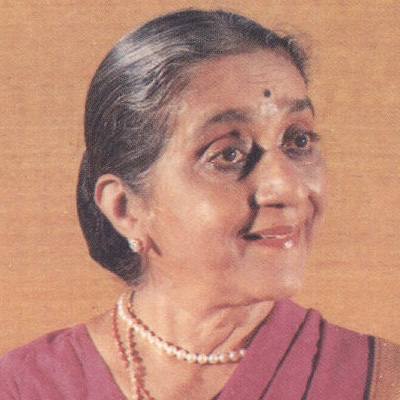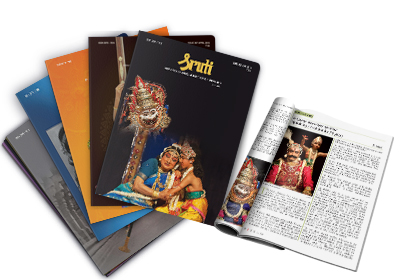
DANCE IS A MANY SPLENDOURED THING, BUT . . .
Take No Liberties, Please !
You must sing only in key. You must dance only in rhythm.
What is provocative about these statements? Nothing. They are basic exhortations about-primary requirements: without maintaining a key, it would not be singing and it can't be dance without rhythm. I am of course referring only to our classical art-forms, in which a sloka, an alapana are the exceptions that are sung without keeping a basic beat.
Experiments in music and dance, with some Indian quotient in it, have been current for the past few decades. These might have passages of toneless singing or a-rhythmic dance. But such novelties remain one-time creations. They do not, in fact, cannot leave behind a grammar by which other compositions, choreographies may come into being.
So when I exhort: "You must start a song only with its pallavi," I refer only to the singing, or dancing to a padam, as a piece. In the classical style. Anything can be done in ballets, in pastiches, in films and plays, in modern creations that depend more on whim than traditionally sanctioned logic. If it serves the immediate purpose, any lyric can be minced and meted out to the audience.
Not so if it is a traditional Carnatic concert or Bharatanatyam performance. I know a few people do it but they are ignoring the inexorable logic of literature and are going against the intent of the composer.
Nedunuri Krishnamurthi and M. Balamuralikrishna gave recitals in the evenings at a two day brou-ugh-ugh marking the 581st jayanti of Tallapaka Annamacharya, organized in Madras by the Annamacharya Project of the Tirupati-Tirumala Devasthanam. (The morning sessions were an unmitigated fiasco, preceded by the organisers praising and garlanding each other, saying things of no import and less imagination about Annamacharya). Both the singers, whose musical scholarship and chaste taste are beyond question, sang all the 40 or so songs starting from the pallavi. Why did they do that? They were not heeding any VAKRAcharya edict, but following good sense. The maximum sense, in the least possible time, is made by starting a song with the pallavi. And paying a homage to the great composer by conceding the point that Annamacharya knew how and with what line his songs should start. Things that the TTD Project singers don't always do, on cassette and in concert. They should learn from the maestros.
In the confrontation arranged by the Fine Arts Foundation- India (Sruti, 55), three people made comments about this pallavi/anupallavi situation. Kalanidhi Narayanan said: "I am an artist. I need the freedom to create. So I sometimes take a padam from the anupallavi." T.S. Parthasarathysaid that he had heard some pada-s always sung from the anupallavi and questioned whether I had ever heard the Kshetrayya padam Ayyayyo vegalayene taken up from anything but the anupallavi 'Payyeda'. Sadanand Menon, after referring to certain proclivities/privileges of critics perhaps best known to himself, said "Mr. Ranga Rao is wrong in saying that songs should start with only the pallavi."
Artists indeed should have the freedom to be creative. Kalanidhi is an undisputed artist of abhinaya and her artistic freedom is not questioned. But does this include going against the wishes of the author? I think not. And can she, or anyone else for that matter, say that a song is made more meaningful only if the anupallavi is taken up first? Which means that the performing artist has more sense and sensibilities than Annamayya or Kshetrayya. Then why not the artist write his or her own songs that make more sense if they are taken up from the second or sixth or the penultimate line, without taking liberties with established classics?
I locateda gramophone record issued 70 years ago. It starts with the anupallavi line 'Payyeda', goes to the pallavi line 'Ayyayyo' and then to the charanam. After the charanam, only 'Payyeda' is sung without going back to 'Ayyayyo'. This makes me feel that the singers of pada-s in those days, who were mostly devadasis and not very literate in Telugu, did not or could not differentiate the pallavi from the anupallavi. In fact, the way 'Payyeda' is sung on this record suggests that the singer was under the impression that this was the pallavi.
Which brings me to the long-winded letter by Dr. Saskia Kersenboom (Sruti 55). She says, amongst other things :"The reference to the pathabheda (sthanam/manam) was But a footnote in my sixty minute talk." In her talk, she clearly claimed that the dancer chose to change it for the better. Evidendy, to strengthen her case, she changes it to a pathabheda. "Emphasis on following the texts scrupulously betrays a dogmatic puritanism of an equally stifling nature as that of the sanitizers." This is followed by: "Everyone will agree that texts should not be altered at random, and that too, certainly not by outsiders."
The fact gleaned from a knowledgeable person close to T. Balasaraswati that the change was pressed upon her by an outsider (noted by the Editor, Sruti) lays dead her claim of an eighth generation dancer developing special authority for changing/sanitizing text. If you are born into a family of fliers, yes you have the right to fly blindfolded and tumble down to death from a trapeze. But whether you are a beginner with no artistic heritage behind you, or an nth generation singer or dancer, you have no right to alter the known lyrics of respected composers. Period.
Literary criticism has not been applied to dance lyrics ? Tell that to the Marines.
I am really sorry that such a scholar as Dr. Saskia chose to drive herself up so frail a limb. It should be remembered that the arguments put forth in this column are not for or against anybody, but sincere attempts to get at what is right, what is true.
One other point should be mentioned.In the early years of the gramophone record, between 1910 and 1930, when many pada-s and Tyagaraja keertana-s were recorded,there was only mechanical recording. That is, only the vocal power had to activate the groove-cutting stylus. There was no electrical amplification. When the pallavi-s started in the middle octave, often-times, the voice was not powerful enough to drown out the surface noise of the grooves and to make a bright audible opening (it must be borne in mind that the players of that time too were handwound, without electrical amplification). So, a few were altered to start with the pallavi. If you take just two songs, Evarani and Manchidinamu nede made immortal respectively by S.G. Kittappa and Coimbatore Thayi, their pallavi-s are in the middle octave and the anupallavi-s, 'Sivudano' and 'Ponchi joochutalane,' soar into the upper octave. So such songs were sometimes recorded starting with the anupallavi-s. Kittappa, in his stage roles too, started with the anupallavi in a high pitch somewhere backstage and made his entrance with the pallavi in the middle octave. The same psychology would have worked at Kalakshetra too, where it is now felt that a padam must be begun with its anupallavi.
One Last Nail.
A singer-cum-journalist (incidentally, her mother is an exemplary vocalist and her daughters are talented dancers) asked me a question : "Didn't you ever compose a song ? Haven't you ever written the anupallavi first?" Taking it for granted that I wrote a song, initially, starting from the anupallavi or charanam, it can be presented in such a serial order only if it was my life that was being balleted on stage. There are people who believe that Tyagaraja started his keertana with 'Balakanakamaya' and then came to the pallavi in Ela nee daya radu. So if it is Tyagaraja's life being presented as a drama or as a ballet, that order can be followed.
Imagine taking the same argument to its limits. A film's climax may be shot first. Should that be shown first? Many short-story writers have divulged that they started with a punch-line at the end and worked backwards to the beginning. Is that how such stories should be read ?
This is the last of my pronouncements on the need to start with the pallavi. Let's get on with other matters.
In my article on the varnam manavi kaikona (Sruti 55), I apologise for omitting the following muktai swara sabityam, which should precede the charana-s 'Sarni nee sati' and three others. These identified as MSS(l) etc., should be taken as charana-s.
MSS Nee neratanamu nee doratanamu
Your proficiency your lordliness
Your abilities, your royal ways
Neeke tagunani talanchaga apudu na madi
to you only fit thought (I) then my mind
are fit only for you, I thought, and then
my mind
bhramasi kalayutaku sahasamu seya
reeled, meet (you) to dare did (I)
reeled, I dared to be with you
tnaguna eevelalo
right is it (at) this time
I wonder whether I did right, at this time
The text has been taken from the Tanjavur Quartet version, making minor modifications as occasioned by transliteration into Tamil. There are other versions, some of which might be equally valid as far as the literary quotient is concerned.
In the above passage, 'tnaguna eevelalo' seems out of place. Or, implies 'is it right for you to delay' (which is not in the text). So the meaning which I have assumed is the heroine contemplating to herself: "Is it right for me to fall for you in this way?"
For 'nee neratanamu', all manners and ways of his prowess in the fine arts can be shown. For 'doratanamu', his royal qualities of valour, chivalry, charitable nature, kindness, protecting the weak, ruling his people with benevolence, patronising the arts, can be illustrated. It should be kept in mind that this should not' become a saga of its own; the length and depiction should be commensurate with the ideas that will be developed later on in the charana-s. The literal aspect of being a king should better be left for 'dharadhipatiyani' in the third charanam.
In the next column, I'll take up a Kshetrayya padam for detailed discussion. Any suggestions about which one it should be?


